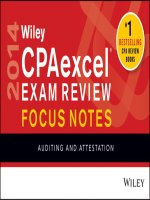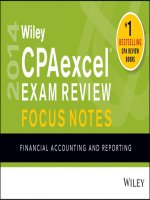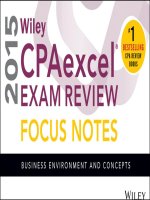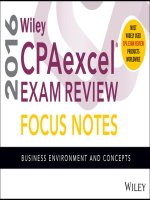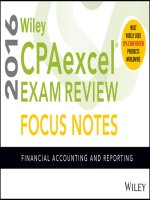2014 WILEY CPA excel focus notes financial accounting
Bạn đang xem bản rút gọn của tài liệu. Xem và tải ngay bản đầy đủ của tài liệu tại đây (3.02 MB, 344 trang )
2014
Wiley
®
CPAexcel
EXAM REVIEW
FOCUS NOTES
2014
Wiley
®
CPAexcel
EXAM REVIEW
FOCUS NOTES
FINANCIAL ACCOUNTING AND REPORTING
Cover Design by David Riedy
Cover image: © turtleteeth/iStockphoto
Copyright © 2014 by John Wiley & Sons, Inc. All rights reserved.
Published by John Wiley & Sons, Inc., Hoboken, New Jersey
Published simultaneously in Canada.
No part of this publication may be reproduced, stored in a retrieval system or transmitted in any form or by any means, electronic,
mechanical, photocopying, recording, scanning or otherwise, except as permitted under Section 107 or 108 of the 1976 United
States Copyright Act, without either the prior written permission of the Publisher, or authorization through payment of the
appropriate per-copy fee to the Copyright Clearance Center, Inc., 222 Rosewood Drive, Danvers, MA 01923, 978-750-8400,
fax 978-750-4470, or on the Web at www.copyright.com. Requests to the Publisher for permission should be addressed to
the Permissions Department, John Wiley & Sons, Inc., 111 River Street, Hoboken, NJ 07030, 201-748-6011, fax 201-748-6008,
or online at />Limit of Liability/Disclaimer of Warranty: While the publisher and author have used their best efforts in preparing this book,
they make no representations or warranties with respect to the accuracy or completeness of the contents of this book and
specifically disclaim any implied warranties of merchantability or fitness for a particular purpose. No warranty may be created
or extended by sales representatives or written sales materials. The advice and strategies contained herein may not be
suitable for your situation. You should consult with a professional where appropriate. Neither the publisher nor author shall be
liable for any loss of profit or any other commercial damages, including but not limited to special, incidental, consequential, or
other damages.
For general information on our other products and services, or technical support, please contact our Customer Care Department
within the United States at 800-762-2974, outside the United States at 317-572-3993 or fax 317-572-4002.
Wiley also publishes its books in a variety of electronic formats. Some content that appears in print may not be available in
electronic books. For more information about Wiley products, visit our Web site at .
ISBN: 978-1-118-81667-7; ISBN: 978-1-118-85414-3 (ebk); ISBN: 978-1-118-87201-7 (ebk)
Printed in the United States of America
10 9 8 7 6 5 4 3 2 1
CONTENTS
Preface
About the Author
About the Contributor
Module 9:
Basic Concepts
Module 10:
Inventories
Module 11:
Module 12:
Module 13:
Fixed Assets
Monetary Assets and Liabilities
Leases
Financial Statements
Long-Term Construction Contracts
1
9
39
62
66
92
121
Bonds
135
Debt Restructure
148
Pensions
Module 14:
Module 15:
Module 16:
vii
ix
ix
Deferred Taxes
Stockholders’ Equity
Investments
152
159
169
195
v
Module 17:
Module 18:
Module 19:
Module 20:
Module 21:
Module 22:
Statement of Cash Flows
Consolidated Statements
Derivative Instruments
Segment Reporting
206
215
230
241
Partnership
244
Foreign Currency
252
Interim Reporting
256
Personal Financial Statements
260
Governmental (State and Local) Accounting
Not-for-Profit Accounting
Index
263
312
327
Contents
vi
PREFACE
This publication is a comprehensive yet simplified study program. It provides a review of all the
basic skills and concepts tested on the CPA exam and teaches important strategies to take
the exam faster and more accurately. This tool allows you to take control of the CPA exam.
This simplified and focused approach to studying for the CPA exam can be used:
•
•
•
As a handy and convenient reference manual
To solve exam questions
To reinforce material being studied
Included is all of the information necessary to obtain a passing score on the CPA exam in a
concise and easy-to-use format. Due to the wide variety of information covered on the exam,
a number of techniques are included:
•
•
•
Acronyms and mnemonics to help candidates learn and remember a variety of rules and
checklists
Formulas and equations that simplify complex calculations required on the exam
Simplified outlines of key concepts without the details that encumber or distract from
learning the essential elements
vii
•
•
•
Techniques that can be applied to problem solving or essay writing, such as preparing
a multiple-step income statement, determining who will prevail in a legal conflict, or
developing an audit program
Pro forma statements, reports, and schedules that make it easy to prepare these items by
simply filling in the blanks
Proven techniques to help you become a smarter, sharper, and more accurate test taker
This publication may also be useful to university students enrolled in Intermediate, Advanced and
Cost Accounting; Auditing, Business Law, and Federal Income Tax classes; and Economics
and Finance classes.
Good luck on the exam,
Ray Whittington, PhD, CPA
Preface
viii
ABOUT THE AUTHOR
Ray Whittington, PhD, CPA, CMA, CIA, is the dean of the College of Commerce at DePaul University. Prior to joining the faculty at DePaul, Professor Whittington was the Director of Accountancy at San Diego State University. From
1989 through 1991, he was the Director of Auditing Research for the American Institute of Certified Public Accountants
(AICPA), and he previously was on the audit staff of KPMG. He previously served as a member of the Auditing Standards
Board of the AICPA and as a member of the Accounting and Review Services Committee and the Board of Regents of
the Institute of Internal Auditors. Professor Whittington has published numerous textbooks, articles, monographs, and
continuing education courses.
ABOUT THE CONTRIBUTOR
Natalie T. Churyk, PhD, CPA, is the Caterpillar Professor of Accountancy at Northern Illinois University. She teaches
in the undergraduate and L.M.A.S. programs as well as developing and delivering continuing professional education
in Northern Illinois University’s CPA Review program. Professor Churyk has published in professional and academic
journals. She serves on state and national committees relating to education and student initiatives and is a member of
several editorial review boards. Professor Churyk is a coauthor on three textbooks: Accounting and Auditing Research:
Tools and Strategies; Accounting & Auditing Research and Databases: Practitioner’s Desk Reference; and Mastering
the Codification and eIFRS: A Case Approach.
ix
OBJECTIVES OF FINANCIAL REPORTING
The objectives of financial reporting are to provide:
•
•
•
•
•
•
Information that is useful to potential and existing investors, lenders, and other creditors
Information about the reporting entity’s economic resources and claims against those
resources
Changes in economic resources and claims
Financial performance reflected by accrual accounting
Financial performance reflected by past cash flow
Changes in economic resources and claims not resulting from financial performance
Focus on
Basic Concepts—Module 9
1
Financial statements are designed to meet the objectives of financial reporting:
Balance Sheet
Statement of Earnings and
Comprehensive Income
Statement of Cash Flows
Financial Statements Taken
as a Whole
Direct Information
Direct Information
Financial Position
Entity Performance
Direct Information
Indirect Information
Entity Cash Flows
Management and Performance
Focus on
Basic Concepts—Module 9
2
Qualitative Characteristics of Accounting Information
Primary Users of
Accounting Information
Existing and Potential Investors, Lenders, and Other Creditors
Pervasive Constraint
Benefits > Costs
Decision Usefulness
Fundamental
Qualitative
Characteristics
Relevance
Predictive
Value
Enhancing
Qualitative
Characteristics
Threshold for
Recognition
Comparability
(consistency
helps achieve
comparability)
Faithful Representation
Complete
Confirmatory
Value
Verifiability
Timeliness
Neutral
Free from Error
Understandability
Materiality
(Entity-specific and related to relevance)
Focus on
Basic Concepts—Module 9
3
IFRS® and U.S. Conceptual Framework as Converged
Fundamental Characteristics/
Decision Usefulness
Relevance
Predictive value
Feedback value
Materiality
Faithful Representation
Completeness
Neutrality
Enhancing Characteristics
Comparability
Verifiability
Timeliness
Understandability
Constraints
Benefit versus costs
Free from error
Focus on
Basic Concepts—Module 9
4
Elements of Financial Statements
Assets – Liabilities = Equity
Equity =
Contributions
by owners
–
Distributions
to owners
=
Comprehensive
Income
Comprehensive
= Revenues – Expenses + Gains – Losses
Income
Comprehensive Income = Net income ± Adjustments to stockholders’ equity
Focus on
Basic Concepts—Module 9
5
IFRS Elements
Assets
Liabilities
Equity
Income (includes both revenues and gains)
Expense (includes expenses and losses)
Focus on
Basic Concepts—Module 9
6
BASIC RULES AND CONCEPTS
Consistency
Realization
Recognition
Allocation
Matching
Full disclosure
Focus on
Basic Concepts—Module 9
7
Revenue Recognition
Accrual method
Collection reasonably assured
Degree of uncollectibility estimable
Installment sale
Cost recovery
Collection not reasonably assured
Collection not reasonably assured
No basis for determining whether or not collectible
Installment Sales Method
Installment receivable balance
× Gross profit percentage
= Deferred gross profit (balance sheet)
Cash collections
× Gross profit percentage
= Realized gross profit (income statement)
Cost Recovery Method
All collections applied to cost before any profit or interest income is recognized
Focus on
Basic Concepts—Module 9
8
Converting from Cash Basis to Accrual Basis
Revenues
Cash (amount received)
Increase in accounts receivable (given)
Decrease in accounts receivable (given)
Revenues (plug)
xx
xx
xx
xx
Cost of Sales
Cost of sales (plug)
Increase in inventory (given)
Decrease in accounts payable (given)
Decrease in inventory (given)
Increase in accounts payable (given)
Cash (payments for merchandise)
xx
xx
xx
xx
xx
xx
Focus on
Financial Statements—Module 9
9
Expenses
Expense (plug)
Increase in prepaid expenses (given)
Decrease in accrued expenses (given)
Decrease in prepaid expenses (given)
Increase in accrued expenses (given)
Cash (amount paid for expense)
xx
xx
xx
xx
xx
xx
Focus on
Financial Statements—Module 9
10
Balance Sheet
Current Assets
Cash
Trading securities
Current securities available for sale
Accounts receivable
Inventories
Prepaid expenses
Current deferred tax asset
Current Liabilities
Short-term debt
Accounts payable
Accrued expenses
Current income taxes payable
Current deferred tax liability
Current portion of long-term debt
Unearned revenues
Focus on
Financial Statements—Module 9
11
Balance Sheet (continued)
Long-Term Investments
Noncurrent securities available for sale
Securities held to maturity
Investments at cost or equity
Property, Plant, and Equipment
Intangibles
Other Assets
Deposits
Deferred charges
Noncurrent deferred tax asset
Long-Term Debt
Long-term notes payable
Bonds payable
Noncurrent deferred tax liability
Stockholders’ Equity
Preferred stock
Common stock
Additional paid-in capital
Retained earnings
Accumulated other comprehensive income
Focus on
Financial Statements—Module 9
12
Current Assets and Liabilities
Assets
Economic resources
Future benefit
Control of company
Past event or transaction
Liabilities
Economic obligation
Future sacrifice
Beyond control of company
Past event or transaction
Current Assets
Converted into cash or used up
Current Liabilities
Paid or settled
OR Requires use of current assets
Longer of:
One year
One accounting cycle
Longer of:
One year
One accounting cycle
Focus on
Financial Statements—Module 9
13



